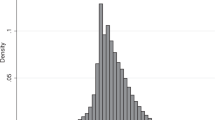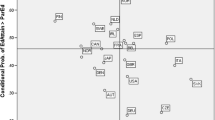Abstract
Research suggests that birth order has a profound influence on personality development, but there has been little research investigating the effect of birth order on a person’s occupational choice. A number of psychologists, including Frank Sulloway and Reid Claxton, argue that first-borns are more likely to become managers because their order in the family trains them in managerial and leadership skills. In contrast, several economists, such as Gary Becker, argue that first-borns are often economically successful because they receive more resources from their parents than other children. This occurs both because they tend to have fewer siblings and because they receive their parents’ unshared attention before their younger siblings are born. Using the National Longitudinal Survey of Youth (NLSY) of 1979, we investigate which of these models best accords with the data. We find that first-borns are indeed more likely to select managerial positions than later-borns, but that this effect is due to first-borns having, on average, fewer siblings than others, not to being first-born per se. Further, we find the effect of family size is strongest among lower-income families, lending support to Becker’s hypothesis.
Similar content being viewed by others
References
Angrist, J. D., & Evans, W. N. (1996). Children and their parents' labor supply: Evidence from exogenous variation in family size. National Bureau of Economic Research, (w5778).
Becker, G. S., & Lewis, H. G. (1974). Interaction between quantity and quality of children. In T. W. Schultz (Ed.), Economics of the family: Marriage, children, and human capital (pp. 81–90). Chicago: University of Chicago Press.
Becker, G., & Tomes, N. (1976). Child endowments and the quantity and quality of children. Journal of Political Economy, 84(4), S143–S162.
Black, S. E., Devereux, P. J., & Salvanes, K. G. (2005). The more the merrier? The effect of family size and birth order on children’s education. The Quarterly Journal of Economics, 669–700.
Blake, J. (1981). Family size and the quality of children. Demography, 18(4), 421–442.
Bureau of Labor Statistics. (2012). National longitudinal survey of youth 1979 cohort, 1979–2010 (rounds 1–24). Columbus: Center for Human Resource Research.
Claxton, R. P. (1994). Empirical relationshships between birth order and two types of parental feedback. The Psychological Record, 44(4), 475.
Earley, P. C., Northcraft, G. B., Lee, C., & Lituchy, T. R. (1990). Impact of process and outcome feedback on the relation of goal setting to task performance. Academy of Management Journal, 33(1), 87–105.
Ernst, C., & Angst, J. (1985). Birth order: its influence on personality. Social Forces, 63(4), 1117–1119.
Hauser, R. M., & Sewell, W. H. (1985). Birth order and educational attainment in full sibships. American Educational Research Journal, 22(1), 1–23.
Herrera, N. C., Zajonc, R., Wieczorkowska, G., & Cichomski, B. (2003). Beliefs about birth rank and their reflection in reality. Journal of Personality and Social Psychology, 85(1), 142.
Iacovou, M. (2008). Family size, birth order, and educational attainment. Marriage & Family Review, 42(3), 35–57.
Kessler, D. (1991). Birth order, family size, and achievement: family structure and wage determination. Journal of Labor Economics, 9(4), 413–426.
Khanam, R. (2008). Child labour and school attendance: evidence from Bangladesh. International Journal of Social Economics, 35(1/2), 77–98.
Khanam, R., & Rahman, M. (2007). Child work and schooling in Bangladesh: the role of birth order. Journal of Biosocial Science, 39(05), 641–656.
Leong, F. T., Hartung, P. J., Goh, D., & Gaylor, M. (2001). Appraising birth order in career assessment: linkages to Holland’s and Super’s models. Journal of Career Assessment, 9(1), 25–39.
Price, J. (2008). Parent–child quality time does birth order matter? Journal of Human Resources, 43(1), 240–265.
Shaver, P., French, J. R., & Cobb, S. (1970). Birth order of medical students and the occupational ambitions of their parents. International Journal of Psychology, 5(3), 197–207.
Sulloway, F. J. (1996). Born to rebel: Birth order, family dynamics, and creative lives. New York: Pantheon Books.
United States Census Bureau (2010). Decennial management division glossary. From https://www.census.gov/dmd/www/glossary.html.
Very, P. S., & Prull, R. W. (1970). Birth order, personality development, and the choice of law as a profession. Journal of Genetic Psychology, 116(2), 219–221.
Westoff, C. F., Potter, R. G., & Sagi, P. C. (1963). The third child: A study in the prediction of fertility. New Jersey: Princeton University Press.
Author information
Authors and Affiliations
Corresponding author
Rights and permissions
About this article
Cite this article
Grinberg, A. The Effect of Birth Order on Occupational Choice. Atl Econ J 43, 463–476 (2015). https://doi.org/10.1007/s11293-015-9474-2
Published:
Issue Date:
DOI: https://doi.org/10.1007/s11293-015-9474-2




